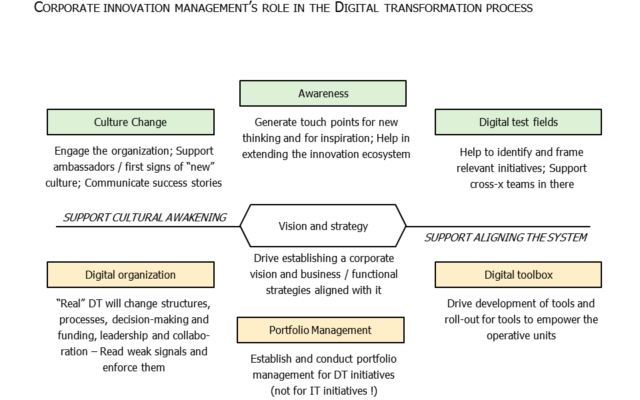“Digital Transformation for growth” (see here) provides a huge opportunity for corporate innovation – but also many challenges. We are exploring how corporate innovation management should move ahead (Note: In this post, we understand ‘corporate innovation management’ to be a corporate function and/or the management process). The first part of this article was about new opportunities that corporate innovation management needs to seize. This second part is about new challenges and how corporate innovation management should engage in the transformation process.
As you will have noticed HERE we have conducted a Peer Group process “Digital Transformation for growth in Process Industries”. In this process, we have cut through the buzz around ‘Digital Transformation’ (DT) and made several deep dives:
- How are the best companies using Digital tools for improving the customer experience along the whole customer life-cycle?
- What do “top customer insights companies” different than the rest?
- How are leading companies using Digital tools for R&D and Innovation?
- How are leading companies designing their DT journey and how do they approach change?
In the first part of this article, we showed that “Digital for R&D and Innovation” means new innovation horizons such as extended products combining physical products and data wraps, digital service and business model innovation, smart and personalized products and also cross-value-chain / cross-industry innovation.
New challenges for corporate innovation management
Nothing comes without a price. And where there are new opportunities, as indicated in the first part of this article, there are also usually new challenges. This sure is the case for Digital. We see six major challenges for corporate innovation management, described in detail below:
- Digital will change the current scope
- Unfamiliar territory – Innovation needs atoms and bits
- New skills – and the best way of building them up
- New innovation horizons require a new innovation strategy
- New innovation ecosystems
- New ways of working
Digital will change the current scope
Of course, every company defines “corporate innovation management” differently. But as a rule of thumb one could say that in many companies, corporate innovation is designed for the target of “pursuing the innovation agenda which is beyond the agenda of the operative Business Units”.
Frequently, one finds within corporate innovation management functions such as Basic Research, Corporate Venture Capital, managing university networks, cross-industry innovation, technology scouting, running “breakthrough technology innovation” incubators, etc.
A recent study showed that globally companies are shifting their R&D budgets from product-related technologies towards software. And if in the future “radical innovation” also means Digital, the functions mentioned above will certainly need to be readjusted. Questions in this context are, for example,
- Should Corporate Venture Capital be extended to relevant start-ups?
- How should cross-industry innovation be repositioned in the light of Digital?
- Which technologies should we scout for now?
- Etc.
Unfamiliar territory – Innovation needs atoms and bits
In the pre-Digital era, the R&D and innovation value stream was one-directional: R&D went into products, products were sold to customers.
Now, in the Digital era, there is a backchannel since the value of the innovation is not only in selling the product or service itself but also in capturing the value from data about when, where and how the customer is using the product or service.
Designing this backchannel requires mastering a new technology stack. For most of the corporate innovators, a big part of this technology stack is unfamiliar territory. Take Smart Products as an example. There, the technology stack includes
- Product hardware and software
- Product applications / the application platform
- Rules / Analytics engine
- Identity and security
- Connectivity
- Gateways to external, 3rd party information sources
- Tools for integration with existing business systems
- Upgradeability of the product over life-cycle via software
If you put yourselves in the shoes of a corporate innovation manager from a Chemicals company you’ll see that your “atoms world” expertise is on the first two bullet points. The third bullet point is a mix of “atoms” and “bits” expertise and the last five bullet points are “bits world” expertise.
New skills – and the best way of building them up
As stated in the last section, winning in new innovation horizons requires expertise from the “atoms world” and the “bits world”. However, most people from corporate innovation management have only a rudimentary knowledge of the Digital concepts (Big Data analytics, Cloud, Blockchain, etc.) that may be pivotal for success.
In trying to seize the opportunities in new innovation horizons, corporate innovation management needs to work with specialized people from Corporate IT (e.g. “data scientists”) and players from other industries with their own terminology and different approaches.
In most of the companies, it is still an open question which Digital skills corporate innovation management should have to master these challenges and how these skills should be built up.
One way of addressing this issue was highlighted in a recent study which focused on the intersection of Big Data and R&D. As a summary, the authors called for “Pi-shaped people”, meaning T-shaped people with a deep expertise in one area, a broad understanding of the context plus one more leg in Digital.
New innovation horizons require a new innovation strategy
We have found that if a company starts to innovate at scale in new innovation horizons it will soon run into very strategic questions. These questions relate to innovation strategy, in some cases even to corporate strategy.
In the case of Smart Products, for example, we frequently find questions like:
- Which set of smart product capabilities should be pursued?
- How much functionality should be in the product and how much in the cloud?
- Should the company innovate openly or closed? Should the innovations aim at an open platform or a closed, proprietary system?
- Should the company develop the full set of smart product capabilities and infrastructure internally or outsource to partners?
- What data must the company capture, secure, and analyze to maximize the value? How does the company manage ownership and access rights to data?
- Should the company enter new businesses by monetizing its product data through selling it to outside parties? Should the company expand its scope? Should the company change its business model?
New innovation ecosystems
Seizing the Digital opportunity means also opening for a new ecosystem of co-innovation partners: New…
- universities that focus on relevant complementary or “bit world” disciplines
- categories of start-ups (e.g. Artificial Intelligence / Machine Learning)
- LargeCos and SMEs which are relevant in the Digital context
Furthermore, in some industries big tech companies like IBM, Alphabet (Google) or Apple will become part of the industry’s R&D fabric. We have found, for example, that Alphabet is investing heavily in various ways to become part of the data and algorithms foundation for R&D in Life Sciences within the next 5 years,
Approaching these new co-innovation partners with a different industry background is also unfamiliar territory. It requires efforts and new approaches.
New ways of working
There is an emerging body of knowledge already available showing that the Digital work style differs significantly from the pre-Digital work style:
- From a customer problem / technology solution thinking to a customer experience thinking
- From a chain of known technologists within the company (product related, process engineers, manufacturing) to a cross-silo thinking
- From a two-track “Here business, there IT”, to a coherent “Business + IT” approach
- From a six-sigma, 0-mistake thinking to a test-and-learn, agile approach
This again poses a new challenge for many corporate innovation managers.
How corporate innovation management should engage in the transformation process
As outlined above, Digital Transformation is a specific challenge for corporate innovation management. Of course, it is also a challenging endeavor for the whole company.
Frequently, corporate innovation wants to play an active role and help in managing the corporate change. Judging by case evidence from several companies, there are three areas in which to engage: Drive establishing a Digital innovation vision; Support the Digital cultural awakening of the organization; Contribute to upgrading the existing innovation management system to the Digital world.
To support the Digital awakening of the organization, corporate innovation management should:
- Engage the organization for thinking in Digital innovation; Support ambassadors / first signs of “new digital innovation” culture; Communicate success stories
- Generate touch points for new digital innovation thinking and for inspiration
- Help in extending the innovation ecosystem
- Help to identify, frame and jump-start early digital innovation initiatives and support cross-x teams in there
To support upgrading the innovation management system to Digital, corporate innovation management should:
- Read weak signals on how Digital will change structures, processes, decision-making and funding, leadership, collaboration, etc. and amplify them
- Establish and conduct portfolio management for digital innovation initiatives (not for IT initiatives!)
- Drive development and roll-out of digital innovation tools to empower the operative units
Please drop me a line if you’d like to get more information about our Peer Group and/or would like to discuss.
Article by channel:
Everything you need to know about Digital Transformation
The best articles, news and events direct to your inbox
Read more articles tagged: Featured, Innovation







